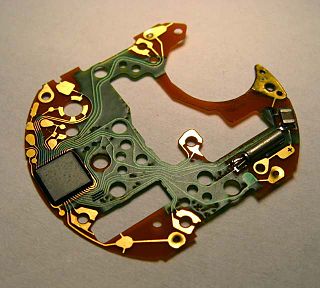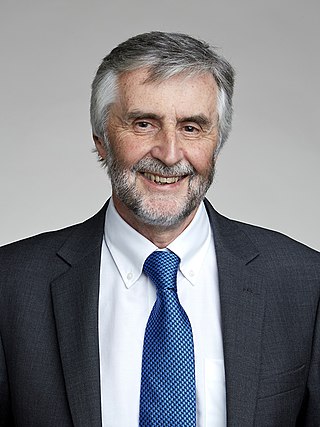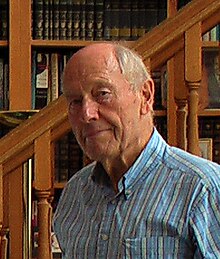
The Allan variance (AVAR), also known as two-sample variance, is a measure of frequency stability in clocks, oscillators and amplifiers. It is named after David W. Allan and expressed mathematically as . The Allan deviation (ADEV), also known as sigma-tau, is the square root of the Allan variance, .
Louis Essen OBE FRS(6 September 1908 – 24 August 1997) was an English physicist whose most notable achievements were in the precise measurement of time and the determination of the speed of light. He was a critic of Albert Einstein's theory of relativity, particularly as it related to time dilation.

Chronometry or horology is the science studying the measurement of time and timekeeping. Chronometry enables the establishment of standard measurements of time, which have applications in a broad range of social and scientific areas. Horology usually refers specifically to the study of mechanical timekeeping devices, while chronometry is broader in scope, also including biological behaviours with respect to time (biochronometry), as well as the dating of geological material (geochronometry).

Bradford Parkinson is an American engineer and inventor, retired United States Air Force Colonel and Emeritus Professor at Stanford University. He is best known as the lead architect, advocate and developer, with early contributions from Ivan Getting and Roger Easton, of the Air Force NAVSTAR program, better known as Global Positioning System.

A crystal oven is a temperature-controlled chamber used to maintain the quartz crystal in electronic crystal oscillators at a constant temperature, in order to prevent changes in the frequency due to variations in ambient temperature. An oscillator of this type is known as an oven-controlled crystal oscillator. This type of oscillator achieves the highest frequency stability possible with a crystal. They are typically used to control the frequency of radio transmitters, cellular base stations, military communications equipment, and for precision frequency measurement.

Quartz clocks and quartz watches are timepieces that use an electronic oscillator regulated by a quartz crystal to keep time. This crystal oscillator creates a signal with very precise frequency, so that quartz clocks and watches are at least an order of magnitude more accurate than mechanical clocks. Generally, some form of digital logic counts the cycles of this signal and provides a numerical time display, usually in units of hours, minutes, and seconds.
The IEEE Joseph F. Keithley Award in Instrumentation and Measurement is a Technical Field Award of the Institute of Electrical and Electronics Engineers (IEEE) that was established by the IEEE Board of Directors in 2001 and first awarded in 2004. It is named in honor of Joseph F. Keithley, the founder of Keithley Instruments, and it replaced the previous IEEE Morris E. Leeds Award, which was named in honor of Morris E. Leeds, an inventor of electrical measuring devices and controls. The award is presented annually for outstanding contributions in electrical measurements, and is sponsored by Keithley Instruments and the IEEE Instrumentation and Measurement Society.

David Jeffery Wineland is an American physicist at the Physical Measurement Laboratory of the National Institute of Standards and Technology (NIST). His most notable contributions include the laser cooling of trapped ions and the use of ions for quantum-computing operations. He received the 2012 Nobel Prize in Physics, jointly with Serge Haroche, for "ground-breaking experimental methods that enable measuring and manipulation of individual quantum systems."

An atomic clock is a clock that measures time by monitoring the resonant frequency of atoms. It is based on atoms having different energy levels. Electron states in an atom are associated with different energy levels, and in transitions between such states they interact with a very specific frequency of electromagnetic radiation. This phenomenon serves as the basis for the International System of Units' (SI) definition of a second:
The second, symbol s, is the SI unit of time. It is defined by taking the fixed numerical value of the caesium frequency, , the unperturbed ground-state hyperfine transition frequency of the caesium-133 atom, to be 9192631770 when expressed in the unit Hz, which is equal to s−1.
Leonard Cutler (1928–2006), also known as Leonard S. Cutler, was a pioneer and authority on ultra-precise timekeeping devices and standards, and was well known for his work with quantum-mechanical effects. He was the co-inventor of the HP5060A Cesium Beam Clock, its successor the HP 5071A, and the two-frequency laser inferometer. He has also been praised for his crucial contributions to the design of the Allen Telescope Array.
Microelectromechanical system oscillators are devices that generate highly stable reference frequencies used to sequence electronic systems, manage data transfer, define radio frequencies, and measure elapsed time. The core technologies used in MEMS oscillators have been in development since the mid-1960s, but have only been sufficiently advanced for commercial applications since 2006. MEMS oscillators incorporate MEMS resonators, which are microelectromechanical structures that define stable frequencies. MEMS clock generators are MEMS timing devices with multiple outputs for systems that need more than a single reference frequency. MEMS oscillators are a valid alternative to older, more established quartz crystal oscillators, offering better resilience against vibration and mechanical shock, and reliability with respect to temperature variation.
Maximum time interval error (MTIE) is the maximum error committed by a clock under test in measuring a time interval for a given period of time. It is used to specify clock stability requirements in telecommunications standards. MTIE measurements can be used to detect clock instability that can cause data loss on a communications channel.

The I. I. Rabi Award, founded in 1983, is awarded annually by IEEE.

Patrick Gill is a Senior NPL Fellow in Time & Frequency at the National Physical Laboratory (NPL) in the UK.
John D. Prestage is an American physicist currently at NASA and an Elected Fellow of the American Physical Society. He pioneered and designed several ion-trap atomic clocks including the physics package for the NASA Deep Space Atomic Clock (DSAC) Technology Demonstration Mission.
The Joseph F. Keithley Award For Advances in Measurement Science is an award of the American Physical Society (APS) that was first awarded in 1998. It is named in honor of Joseph F. Keithley, the founder of Keithley Instruments. The award is presented annually for outstanding contributions in measurement techniques and equipment, and is sponsored by Keithley Instruments and the Topical Group on Instrument and Measurement Science (GIMS).
The Dick effect is an important limitation to frequency stability for modern atomic clocks such as atomic fountains and optical lattice clocks. It is an aliasing effect: High frequency noise in a required local oscillator (LO) is aliased (heterodyned) to near zero frequency by a periodic interrogation process that locks the frequency of the LO to that of the atoms. The noise mimics and adds to the clock's inherent statistical instability, which is determined by the number of atoms or photons available. In so doing, the effect degrades the stability of the atomic clock and places new and stringent demands on LO performance.
Bernard René Guinot (1925–2017) was a French astronomer. He is known for his contributions to the establishment of temps atomique international (TAI) and the geodetic reference system used in satellite navigation.
John Kitching is a British–Canadian–American physicist and inventor, and a fellow and group leader at the National Institute of Standards and Technology. His research focuses on the development of compact "chip-scale" devices such as atomic clocks and magnetometers.









